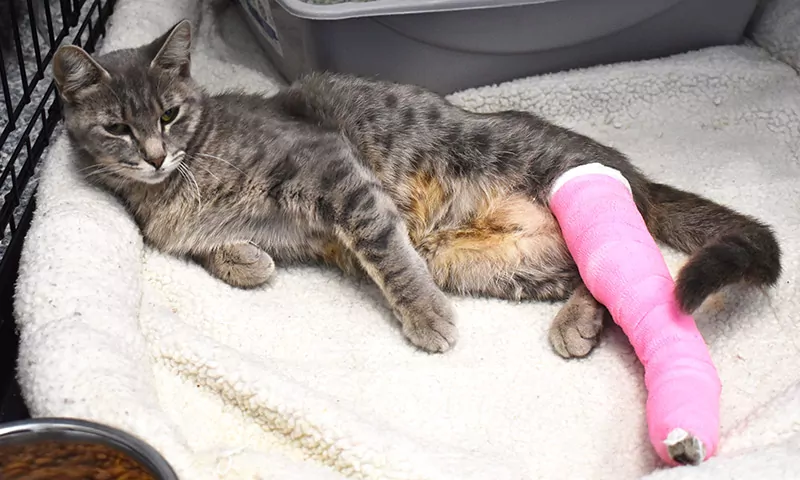0
Dealing with the discovery of a cat suffering from a broken leg and pelvis is both distressing and demanding. Immediate and attentive action is vital, as these injuries can pose a serious threat to the cat’s life if not treated properly. This situation not only calls for medical intervention but also has a significant emotional impact on the pet owner.
Emergency Response and Veterinary Care
In such an emergency, the priority is to safely transport the cat to a veterinary clinic or hospital. Gentle handling is crucial to prevent worsening the injury. Using a makeshift stretcher or a flat surface for transportation is advisable to limit movement. Staying calm is essential, as cats can pick up on their owner’s anxiety, potentially increasing their stress.
Upon arrival at the veterinary clinic, the emergency team will quickly evaluate the cat’s condition. This initial examination is critical for assessing the extent of the injuries and stabilizing the cat. A physical examination will be performed, followed by necessary diagnostics like X-rays to understand the exact nature and severity of the fractures. This enables the vet to plan the most effective treatment.
The prognosis depends on various factors, including the injury’s severity and location, as well as the cat’s overall health and age. Treatment options may vary from surgical stabilization of the bones to conservative management with pain relief and rest, tailored to each case. The vet will discuss these options, focusing on both immediate and long-term impacts on the cat’s health and quality of life.
Emotional Impact on the Owner
For the pet owner, this initial phase can be emotionally taxing, characterized by anxiety, worry, and urgency. Feelings of shock, guilt, or helplessness are common. Seeking support from veterinary staff, friends, or family is important. The veterinary team will provide not just medical support but also guidance and reassurance.
Owners should be encouraged to actively participate in the decision-making process for their pet’s care. This involvement can help in managing the emotional challenges of this experience.
Post-Trauma Veterinary Treatment
Treatment for a cat with significant injuries like a broken leg and pelvis involves complex decision-making, post-operative care, and understanding the associated costs.
Treatment Options and Decision Making
Treatment varies from surgery for severe fractures to conservative management. Surgery may involve pins, plates, or screws for bone alignment and stabilization. If surgery is not feasible, immobilization and pain management may be recommended.
Informed decisions about treatment require detailed discussions with the veterinarian about the pros and cons of each option and their implications for the cat’s health and quality of life.
Post-Operative Care
This involves pain management, wound care, and preventing the cat from disturbing the surgical site. The first few days post-surgery are critical for monitoring for infection or complications. A gradual return to normal activity, with movement restrictions, is necessary for proper healing. Follow-up veterinary visits are crucial.
Cost Considerations
The costs for treatment, including surgery, anesthesia, hospitalization, and follow-up care, can be substantial. Pet insurance, payment plans from veterinary clinics, and support from animal welfare organizations can help manage these expenses.
Setting Up a Healing Environment at Home
Creating an optimal home environment for recovery is crucial. This involves establishing a safe space, managing pain, and ensuring proper nutrition and hydration.
Creating a Safe Space
Designate a quiet, accessible area for the cat to rest, away from high traffic and disturbances. Comfortable bedding, easy to clean, and a recovery area at a comfortable temperature are essential.
Managing Pain and Discomfort
Administer prescribed pain medication as directed. Observe for signs of pain, such as reluctance to move or loss of appetite, and contact the veterinarian for any concerns.
Nutrition and Hydration
Offer small, frequent meals of palatable food to encourage eating. Ensure constant access to fresh water and monitor the cat’s intake.
Daily Care and Mobility Assistance
Caring for a cat with limited mobility involves helping with movement, maintaining hygiene, and potentially incorporating rehabilitation exercises.
Assisting with Mobility
Gently assist the cat to move, supporting their body fully, especially the injured area. Make essentials like food, water, and litter boxes easily accessible.
Hygiene and Grooming
Regular grooming is important, especially for long-haired breeds. Keep the litter box clean and easily accessible, using low-sided boxes for ease.
Physical Therapy and Rehabilitation
Engage in veterinary-guided physical therapy. This might include passive and active exercises and, in specialized cases, aquatic therapy.
The Emotional Journey and Bonding
Navigating the emotional journey during recovery can deepen the bond between the cat and its owner.
Emotional Support for the Cat
Create a comforting environment, maintain a consistent routine, and offer gentle interaction. Responsive care to any distress signs is important.
Coping Strategies for the Owner
Educate yourself about the cat’s condition, connect with support networks, practice self-care, and seek professional guidance when needed. Patience and understanding are key throughout the healing process.
Caring for a Cat with a Broken Leg and Pelvis: Insights from a Pet Owner’s Journey
Monitoring and Managing Complications
Be vigilant for signs of complications such as infection, poor healing, or behavioral changes. Contact the veterinarian immediately upon noticing any concerning signs. Adjust care routines as needed, based on the cat’s recovery stage.
Long-Term Recovery and Adaptation
Long-term recovery may involve adapting to changes in the cat’s mobility or behavior. Celebrating small milestones in recovery is important for both the cat and the owner.
Reflections and Key Takeaways
Caring for a seriously injured cat is a journey of resilience, empathy, and the deepening of the human-animal bond. It emphasizes the importance of prompt action, creating a safe environment, managing pain, and being patient and consistent in care. Emotional support for both the cat and the owner is crucial.
Seek out veterinary resources, support groups, rehabilitation centers, educational websites, and books for additional guidance and support. This journey, while challenging, is rich in lessons and the strengthening of bonds.

